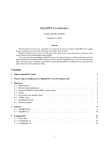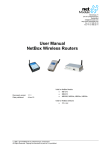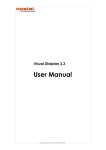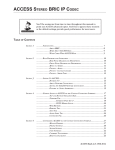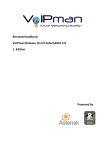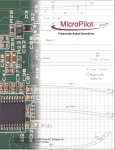Download Siproxd Users Guide
Transcript
Siproxd Users Guide Thomas Ries Siproxd Users Guide by Thomas Ries Copyright © 2005-2009 Thomas Ries This document can be freely redistributed according to the terms of the GNU General Public License. Revision History Revision 0.1 2005-04-10 Revised by: [email protected] Initial version Revision 0.2 2006-07-28 Revised by: [email protected] Comment on Asterisk Scenario Revision 0.3 2007-05-15 Revised by: [email protected] New Asterisk Config Files Revision 0.7.1 2008-01-27 Revised by: [email protected] Plug-in API Table of Contents README ................................................................................................................................1 Important / Warning ...................................................................................................1 1. Overview ............................................................................................................................3 2. Building and Installation ................................................................................................5 2.1. Prerequisites...........................................................................................................5 2.2. Compiling and Installing .....................................................................................5 3. Configuration.....................................................................................................................7 3.1. The configuration file ’siproxd.conf’ ..................................................................7 3.2. Command Line Options.....................................................................................10 4. Features .............................................................................................................................11 4.1. Custom Firewall Module ...................................................................................11 4.2. Chroot() Jail ..........................................................................................................11 5. Plug-ins .............................................................................................................................13 5.1. Plug-in API...........................................................................................................13 5.2. Available Plug-ins ...............................................................................................14 5.2.1. Demo Plug-in ..........................................................................................14 5.2.2. Call Logging Plug-in ..............................................................................14 5.2.3. Short Dial Plug-in ...................................................................................15 5.2.4. Default Target Plug-in............................................................................15 5.2.5. Fix bogus Via Plug-in .............................................................................15 6. Troubleshooting ..............................................................................................................17 6.1. Problem Reporting ..............................................................................................17 6.2. Create a Debug Log.............................................................................................17 6.3. Siproxd crashes....................................................................................................17 7. Sample Configurations ..................................................................................................19 7.1. The "Standard Scenario".....................................................................................19 7.2. GS BT-100 behind NAT Router running Siproxd ...........................................19 7.3. GS BT-100 with Siproxd running "in front of" a NAT router ........................20 7.4. Transparent SIP Proxy ........................................................................................21 7.5. Masquerading an Asterisk box .........................................................................22 iii iv README Important information, please read me! Important / Warning As it still happens that people try to mix different NAT traversal techologies together with siproxd I’ll put some words here: • Do NOT USE anything like an STUN Server together with siproxd. • Do NOT USE any additional techologies trying to help in NAT traversal (additional firewall modules like ip_nat_sip.ko or whatever fancy stuff may tempt you). If you do not follow the above rules, those other "helping technologies" WILL DO CONFLICT with siproxd and result in a mess. 1 Chapter . README 2 Chapter 1. Overview Siproxd is an proxy/masquerading daemon for the SIP protocol. It handles registrations of SIP clients on a private IP network and performs rewriting of the SIP message bodies to make SIP connections possible via an masquerading firewall. It allows SIP clients (like kphone, linphone) to work behind an IP masquerading firewall or router. SIP (Session Initiation Protocol, RFC3261) is used by Softphones and Hardphones (Voice over IP) to initiate communication. By itself, SIP does not work via masquerading firewalls as the transfered data contains IP addresses and port numbers. There exist so called STUN servers that allow a SIP client to figure out its public visible IP address and use this one instead. As a drawback, usually on the masquerading firewall a very wide port range must be opened up for the incoming RTP traffic. The SIP client must support STUN (which most of them do). Siproxd uses another approach (application layer proxy) and places itself as outbound proxy in between the local SIP client and the remote client or registrar. It does rewrite the SIP traffic on the fly and also includes a RTP proxy for incoming and outgoing RTP traffic (the actual audio data). The port range to be used for receiving RTP data is configurable, so the firewall only must allow incoming traffic for a small port range. A standard scenario would look like: private IP address range 10.0.0.x : Internet : (public IP address range) : : foo.bar.org +-------------+ +--------------+ ! !.10 .1 ! masquerading ! publicIP ! IntHost !---------------! Firewall !------------>> ! ! ! ! +-------------+ +--------------+ eth0 : ppp0 • The Firewall does IP masquerading and is running siproxd • IntHost is running an SIP softphone (like linphone, kphone) • The SIP address used by the softphone is sip:[email protected] • The softphone is configured to register itself at siproxd running on the firewall host (10.0.0.1) as sip:[email protected] • foo.bar.org is the domain name corresponding to the public IP address of the firewall (e.g. use some dynamic DNS service [1]) 3 Chapter 1. Overview 4 Chapter 2. Building and Installation 2.1. Prerequisites Operating system of either: • Linux (should work with any kernel) • FreeBSD • Solaris (porting is still being worked on but you may try it) Additional required Packages: • Libosip2 package1 2.2. Compiling and Installing It is quite simple. If you have a more-or-less standard installation and libosip2 installed at a standard location, it should be sufficient to do: ./configure make make install This will install siproxd into /usr/local/. If you wish to install it into another location, specify --prefix=<myprefix> when running ./configure. If you have installed libosip2 in an non-standard location use --with-libosip-prefix=<libosipprefix> to tell configure where to find libosip2 (e.g. --with-libosip-prefix=$HOME/lib). Common features for ./configure: --enable-static --with-libosip-prefix=DIR --with-extra-includes=DIR --with-extra-libs=DIR build statically linked executable use libosip2 from DIR/include and DIR/lib adds non standard include paths adds non standard library paths Edit /usr/etc/siproxd.conf according to your situation, at least configure if_inbound and if_outbound. They must represent the interface names (e.g. on Linux: ppp0, eth1) for the inbound and outbound interfaces. Edit /usr/etc/siproxd_passwd.cfg if you enable client authentication. Start siproxd: # siproxd Notes 1. http://www.gnu.org/software/osip 5 Chapter 2. Building and Installation 6 Chapter 3. Configuration 3.1. The configuration file ’siproxd.conf’ Siproxd by default searches for its configuration file in the following locations: • $HOME/.siproxdrc • <buildingprefix>/etc/siproxd.conf • /etc/siproxd.conf • /usr/etc/siproxd.conf • /usr/local/etc/siproxd.conf The following is a list of directives that do exist. Note that string values MUST NOT contain spaces or tabs. Also read the explanations included in the supplied example configuration file fro more explanation. Items with a # in front are normally disabled / not defined. To start with siproxd in the first run, just adapt the interface definition for the inbound and outbound network interfaces (if_inbound and if_outbound). Definition of network interfaces for the inbound network (local network where your SIP client is connected, this network normally uses IP addresses from on of the private IP ranges like 10.x.x.x, 192.168.x.x) and outbound network (your connection to the Internet, normally this interface has a public IP assigned by your provider). if_inbound = eth0 if_outbound = ppp0 Usually only the if_inbound and if_outbound directives will be used. The host_outbound directive comes into play when running siproxd "in front of" a NAT router. Please check the configuration examples in this document for more details. # host_outbound = <my_public_ip_address> Access control lists for incoming SIP registrations and SIP traffic in general. These are comma separated lists of the form <IP>/<mask>, note that no spaces are allowed within the list (the configuration file parser cannot yet handle spaces). # hosts_allow_reg = 192.168.1.0/24,192.168.2.0/24 # hosts_allow_sip = 123.45.0.0/16,123.46.0.0/16 # hosts_deny_sip = 10.0.0.0/8,11.0.0.0/8 Port to listen for incoming SIP messages. 5060 is usually the correct choice, don’t change this unless you have a reason to. sip_listen_port = 5060 Shall siproxd run as daemon? Usually 1 is the correct choice. If you want siproxd not to daemonize and keep running in foreground and writing its output to the terminal set this to 0. daemonize = 1 Siproxd does log using the syslog() facility when running a daemon. This setting controls how much logging is done: 7 Chapter 3. Configuration • 0 - DEBUGs, INFOs, WARNINGs and ERRORs • 1 - INFOs, WARNINGs and ERRORs • 2 - WARNINGs and ERRORs • 3 - only ERRORs • 4 - absolutely nothing silence_log = 0 If siproxd is started as root, it can drop the root privileges and change its user ID at startup. It also can put itself into a chroot() jail (see 4.2 for details) user = nobody # chrootjail = /var/lib/siproxd/ Where to store the current registrations. This allows siproxd to remember registration across a restart. An empty value means we do not save registrations. The specified directory path must exist. registration_file = /var/lib/siproxd/siproxd_registrations Where to create the PID file. pid_file = /var/run/siproxd/siproxd.pid Enable/disable the RTP proxy. This must always be enabled. In some future release this directive may become obsolete. rtp_proxy_enable = 1 Port range (UDP) that siproxd will use for incoming and outgoing RTP traffic. A firewall must be configured to allow traffic from and to these ports (UDP only). By default the range 7070 up to (and including) 7089 is used. This allows up to 10 simultaneous calls (2 ports per call). If you need more simultaneous calls, increase the range. rtp_port_low = 7070 rtp_port_high = 7089 Timeout for an RTP stream. If for the specified number of seconds no data is relayed on an active stream, it is considered dead and will be killed. rtp_timeout = 300 If a REGISTER request does not contain an Expires header or expires= parameter in the Contact header, this number of seconds will be used and reported back to the UA in the answer. default_expires = 600 If siproxd is used as registration server and authentication is wanted, define the following directive. If proxy_auth_realm is defined (a string), clients will be forced to authenticate themselfs to the proxy (for registration only). To disable Authentication, simply comment out this line. Default is disabled. # proxy_auth_realm = Authentication_Realm The password to be used for authentication may be a global one # proxy_auth_passwd = some_password 8 Chapter 3. Configuration or on a per user base, stored in its own file. proxy_auth_pwfile takes precedence over proxy_auth_passwd # proxy_auth_pwfile = /etc/mysiproxd_passwd.cfg To enable additional debug output of siproxd. This is a bit pattern representing the following items. Default is 0x0 - disabled. See below in this document for information on how to create a debug log file. • DBCLASS_BABBLE 0x00000001 // babble (like entering/leaving fnc) • DBCLASS_NET 0x00000002 // network • DBCLASS_SIP 0x00000004 // SIP manipulations • DBCLASS_REG 0x00000008 // Client registration • DBCLASS_NOSPEC 0x00000010 // non specified class • DBCLASS_PROXY 0x00000020 // proxy • DBCLASS_DNS 0x00000040 // DNS stuff • DBCLASS_NETTRAF 0x00000080 // network traffic • DBCLASS_CONFIG 0x00000100 // configuration • DBCLASS_RTP 0x00000200 // RTP proxy • DBCLASS_ACCESS 0x00000400 // Access list evaluation • DBCLASS_AUTH 0x00000800 // Authentication debug_level = 0x00000000 You may connect to this port from a remote machine and receive the debug output. This allows bettwer creation of debug output on embedded systems that do not have enough memory for large disk files. Port number 0 means this feature is disabled. debug_port = 0 Some UAs (SIP clients) will always use the host/ip they register TO as host part in the registration record (which will be the inbound ip address/hostname of the proxy) and can not be told to register a different host (public IP address). This Mask feature allows to force such a UA to be masqueraded to a different host. Siemens SIP Phones seem to need this feature. Normally disabled. # mask_host=local.ip.of.sipphone # masked_host=public.domaind.org Siproxd itself can be told to send all traffic to another outbound proxy. You can use this feature to ’chain’ multiple siproxd proxies if you have several masquerading firewalls to cross. Normally disabled. # outbound_proxy_host = my.outboundproxy.org # outbound_proxy_port = 5060 Outbound proxies can be specified on a per-domain base. This allows to use an outbound proxy needed for ProviderA and none (or another) for ProviderB. Multiple domain specific proxies may be specified, each one with one set of the following directives. Note: These directives must always be specified as a triple, skipping one of them will affect later definitions. #outbound_domain_name = freenet.de 9 Chapter 3. Configuration #outbound_domain_host = proxy.for.domain.freende.de #outbound_domain_port = 5060 Siproxd supports dynamic loadable plug-ins. Such plug-ins are loaded during runtime and do not require recompilation of the executable. This allows the easy addition of specific functionality to siproxd. Even 3rd party functional extensions are possible without the requirement to patch and rebuild the siproxd source code with each new release. Note: Dynamic loading of shared libraries is not supported on all platforms. If a platform does not support it, plug-ins can still be used but they will be statically linked during the build process of siproxd. The configuration ("loading" the plugins) is identical. For more information on this topic you may familiarize yourself with libltdl. Note: As the plug-in mechanism uses LTDL, the plugins to load MUST use a .la extension and not an .so extension! Trying to load an plugin using xxx.so as it’s name will fail. # plugin_dir: MUST be terminated with ’/’ plugindir=/usr/lib/siproxd/ # List of plugins to load: #load_plugin=plugin_demo.la load_plugin=plugin_logcall.la 3.2. Command Line Options Siproxd knows the following command line options: -h, -d, -c, -p, --help --debug <pattern> --config <cfgfile> --pid-file <pidfile> help set debug-pattern use the specified config file create pid file at <pidfile> These options take precedence over the values configured in the configuration file. 10 Chapter 4. Features 4.1. Custom Firewall Module The API make your library example code ./configure --with-custom-fwmodule=LIBRARY.a 4.2. Chroot() Jail Create chroot jail What files must be present? To be completed! 11 Chapter 4. Features 12 Chapter 5. Plug-ins 5.1. Plug-in API Siproxd plug-ins are dynamic loadable libraries and must provide 3 functions towards siproxd. As we make use of some libltdl features we do some internal macor magic - the PLUGIN_xxx funcation names are actually CPP macros that will expand in unique names. Th have this working properly the PLUGIN_NAME must be #defined before the plugins.h header file is included: #define PLUGIN_NAME plugin_myplugin #include "plugins.h" [...] int PLUGIN_INIT(plugin_def_t *plugin_def); int PLUGIN_PROCESS(int stage, sip_ticket_t *ticket); int PLUGIN_END(plugin_def_t *plugin_def); The PLUGIN_INIT function is called when the plug-in is loaded during startup of siproxd. The plug-in must define the following 4 fields of the plugin_def structure: 1. api_version 2. name 3. desc 4. exe_mask Example code fragment: /* API version number of siproxd that this plug-in is built against. * This constant will change whenever changes to the API are made * that require adaptions in the plug-in. */ plugin_def->api_version=SIPROXD_API_VERSION; /* Name and descriptive text of the plug-in. Those item MUST NOT be on the stack but either allocated via malloc (and then freed of course) or a static string in the plug-in. */ plugin_def->name=strdup("plugin_demo"); plugin_def->desc=strdup("This is just a demo plugin without any purpose"); /* Execution mask - during what stages of SIP processing shall * the plug-in be called. */ plugin_def->exe_mask=PLUGIN_DETERMINE_TARGET|PLUGIN_PRE_PROXY; The PLUGIN_PROCESS function is called at the requested SIP processing stages (see ’execution mask’). Your processing will be done here. The PLUGIN_END function is called at shutdown of siproxd and gives the plug-in the opportunity to clean up and properly shutdown itself. Note: The previously allocated ’name’ and ’desc’ must be freed by the plug-in. If you did use a static string then of course you must not try to free() anything. Minimum required clean up procedure: int PLUGIN_END(plugin_def_t *plugin_def){ /* free my allocated rescources (if allocated via malloc only) */ if (plugin_def->name) {free(plugin_def->name); plugin_def->name=NULL;} if (plugin_def->desc) {free(plugin_def->desc); plugin_def->desc=NULL;} return STS_SUCCESS; } 13 Chapter 5. Plug-ins For a simple example refer to the simple demonstration plug-in plugin_demo. Each plug-in can have its own set of configuration parameters in siproxd.conf. The plug-in has to define a cfgopts_t structure and call read_config during its initialization. Look at plugin_demo for a simple example. The naming of the config parameters is by definition plugin_name_option. 5.2. Available Plug-ins The following plug-ins are provided with siproxd: 1. plugin_demo Demo plug-in. Provides the basic framework to be used for plug-ins. 2. plugin_logcall Very simplistic call logging to syslog. 3. plugin_shortdial Quick Dial feature. 4. plugin_defaulttarget Incoming calls to a non-existing UA are redirected to a specific target (catch-all). 5. plugin_fix_bogus_via Fixes broken VIA headers on incoming calls. Some of the plug-ins are described in more detail in the following chapters. 5.2.1. Demo Plug-in Name: plugin_demo Purpose: To be used as skeletton for your own plug-ins. Configuration options: plugin_demo_string = This_is_a_string_passed_to_the_demo_plugin Description: This plug-in can be used as framework for your own plug-ins. It contains the required code for the API and also shows how to load plug-in specific configuration parameters. 5.2.2. Call Logging Plug-in Name: plugin_logcall Purpose: Does a very simplistic call logging to syslog. Configuration options: none 14 Chapter 5. Plug-ins Description: The numbering starts with "1" ("*01") and every following "plugin_shortdial_entry" entry will allocate the following position. It is not possible to freely assign the positions. 5.2.3. Short Dial Plug-in Name: plugin_shortdial.c Purpose: Provides a quick-Dial feature. Configuration options: # The first character is the "key", the following characters give # the length of the number string. E.g. "*00" allows speed dials # from *01 to *99. (the number "*100" will be passed through unprocessed) plugin_shortdial_akey = *00 # # *01 sipphone echo test plugin_shortdial_entry = 17474743246 # *02 sipphone welcome message plugin_shortdial_entry = 17474745000 Description: Allows the definition of quick dial entries. E.g. *01 to *99 can be defined to redirect the caller. Note: Currently only the user part (phone number) can be replaced, the domain part will not be changed (means a short dial tarket of sip:[email protected] will not work). The ’*’ character can be chosen freely (plugin_shortdial_akey). Note: To call a real number like "*12" you have to dial "**12" 5.2.4. Default Target Plug-in Name: plugin_defaulttarget Purpose: Incoming calls to non-existing local UAs are redirected to another SIP URI. Configuration options: # Log redirects to syslog plugin_defaulttarget_log = 1 # target must be a full SIP URI with the syntax # sip:user@host[:port] plugin_defaulttarget_target = sip:[email protected]:port Description: Incoming SIP calls directed to a non-existing (registered) local UA will be redirected to another target. This basically implements a catch-all feature. The new target can be any SIP URI and is not required to be local. 5.2.5. Fix bogus Via Plug-in Name: plugin_fix_bogus_via Purpose: Fixes broken VIA headers on incoming SIP requests. Configuration options: # # # # Incoming (from public network) SIP messages are checked for broken SIP Via headers. If the IP address in the latest Via Header is part of the list below, it will be replaced by the IP where the SIP message has been received from. 15 Chapter 5. Plug-ins plugin_fix_bogus_via_networks = 10.0.0.0/8,172.16.0.0/12,192.168.0.0/16 Description: Fixes broken VIA headers on incoming SIP requests (inspired by Ralph Babel, see http://babel.de/art20080317a.html for more info). Can be applied if you have remote UAs calling you from the Internet and those UAs do have crappy Via headers (like private IPs because there is some NAT involved on their side). 16 Chapter 6. Troubleshooting 6.1. Problem Reporting If you encounter problems/crashes and ask for support, please include as much information as possible. Very helpful is a debug log that has been recorded at the time of the misbehavior. Also include the exact versions of the siproxd package and libosip2 that you are using. You should also include your siproxd.conf. 6.2. Create a Debug Log The easiest way to generate a debug log is: 1. make sure siproxd is not started as daemon (’daemonize = 0’ in the config file) 2. start siproxd: $ ./siproxd -d -1 2>debug.log 3. reproduce the error 4. include the generated debug.log in your error report Another possibility of to use TCP logging. This method is recommended if you run siproxd on a router with limited disk space (e.g. an embedded system). To enable TCP logging: 1. Edit the configuration file and set debug_port to 5050 (or any other TCP port number you like). 2. Restart siproxd 3. $ telnet <IP_of_siproxd> 5050 > debug.log You may prefer to use netcat instead of telnet. Note: The TCP debug port is bound to all available interfaces on the system, make sure no unauthorized people (like from the outbound network) can connect. 6.3. Siproxd crashes If siproxd crashes, a stack back trace usually is helpful to me: 1. start siproxd in the debugger (daemonize set to 0): $ gdb ./src/siproxd (gdb) set args -c /path/to/siproxd.conf (gdb) run 2. reproduce the crash 3. use gdb to print the stack backtrace: (gdb) info thread ... (gdb) bt #0 0x400ec9ee in __select () #1 0xbffff6f8 in ?? () 17 Chapter 6. Troubleshooting #2 #3 0x804a5c2 in main (argc=3, argv=0xbffffc54) at siproxd.c:186 0x4005bcb3 in __libc_start_main (main=0x804a30c <main>, argc=3, argv=0xbffffc54, init=0x8049a08 <_init>, fini=0x804edac <_fini>, rtld_fini=0x4000a350 <_dl_fini>, stack_end=0xbffffc4c) at ../sysdeps/generic/libc-start.c:78 (gdb) 4. copy-paste all the output and include it in your problem report. 18 Chapter 7. Sample Configurations Check also the FAQ in the siproxd package. 7.1. The "Standard Scenario" Scenario: private IP address range 10.0.0.x : Internet : (public IP address range) : : foo.bar.org +-------------+ +--------------+ ! !.10 .1 ! masquerading ! publicIP ! IntHost !---------------! Firewall !------------>> ! ! ! ! +-------------+ +--------------+ eth0 : ppp0 The Firewall does IP masquerading and is running siproxd. IntHost is running an SIP softphone (like linphone, kphone). The SIP address used by the softphone is sip:[email protected]. The softphone is configured to register itself at siproxd running on the firewall host (10.0.0.1) as sip:[email protected]. Foo.bar.org is the domain name corresponding to the public IP address of the firewall (e.g. use some dynamic DNS service like DynDNS). Firewall configuration (iptables): # allow incoming SIP and RTP traffic iptables -A INPUT -m udp -p udp -i ppp0 --dport 5060 -j ACCEPT iptables -A INPUT -m udp -p udp -i ppp0 --dport 7070:7089 -j ACCEPT Firewall configuration (ipchains): # allow incoming SIP and RTP traffic ipchains -A input --proto udp --dport 5060 -j ACCEPT ipchains -A input --proto udp --dport 7070:7089 -j ACCEPT The first line will allow incoming SIP traffic. The second line will allow incoming RTP traffic on the ports 7070 - 7089 (the default port range used by siproxd for incoming RTP traffic). 7.2. GS BT-100 behind NAT Router running Siproxd Scenario: private IP address range 10.0.0.x : Internet : (public IP address range) : : foo.bar.org +-------------+ +--------------+ ! !.10 .1 ! masquerading ! publicIP ! SIP UA !---------------! Firewall !------------>> ! BT-100 ! ! siproxd ! +-------------+ +--------------+ eth0 : ppp0 Siproxd is running on the same host as the masquerading firewall. The SIP phone is a Grandstream BudgeTone-100. In this example the external SIP registrar used is sipphone.com1. siproxd.conf: 19 Chapter 7. Sample Configurations if_inbound = eth0 if_outbound = ppp0 hosts_allow_reg = 10.0.0.0/24 sip_listen_port = 5060 daemonize = 1 silence_log = 1 user = siproxd registration_file = /var/lib/siproxd_registrations pid_file = /var/run/siproxd/siproxd.pid rtp_proxy_enable = 1 rtp_port_low = 7070 rtp_port_high = 7089 rtp_timeout = 300 default_expires = 600 debug_level = 0 debug_port = 0 Firewall configuration (iptables): # allow incoming SIP and RTP traffic iptables -A INPUT -m udp -p udp -i ppp0 --dport 5060 -j ACCEPT iptables -A INPUT -m udp -p udp -i ppp0 --dport 7070:7089 -j ACCEPT Phone configuration (only the relevant items are listed): IP Address: 10.0.0.10 Subnet Mask: 255.255.255.0 Default Router: 10.0.0.1 DNS Server 1: <DNS Server of your Internet provider> SIP Server: proxy01.sipphone.com Outbound Proxy: 10.0.0.1 SIP User ID: 1747669xxxx Authenticate ID: 1747660xxxx Authenticate Passwd: ********* Name: Your Name Here Use DNS SRV: no User ID is phone #: no Sip Registration: yes Unregister on reboot:no Register expiration: 60 Early Dial: no local SIP port: 5060 local RTP port: 5004 Use random port: yes NAT traversal: no Use NAT IP: <empty> Subscribe for MWI: No Send DTMF: via RTP (RFC2833) 7.3. GS BT-100 with Siproxd running "in front of" a NAT router Scenario: private IP address range 10.0.0.x : Internet : (public IP address range) : : foo.bar.org +-------------+ +--------------+ ! !.10 .1 ! masquerading ! publicIP ! SIP UA !---------------! NAT router !------------>> ! BT-100 ! ! ! ! +-------------+ ! +--------------+ ! eth0 : ppp0 ! : 20 Chapter 7. Sample Configurations ! eth0 !.2 +-------------+ ! siproxd ! ! ! +-------------+ : Siproxd is running on 10.0.0.2. The masquerading NAT router (e.g. a ADSL NAT router that cannot run any user applications). siproxd.conf: if_inbound = eth0 if_outbound = eth0 host_outbound = foo.bar.org hosts_allow_reg = 10.0.0.0/24 sip_listen_port = 5060 daemonize = 1 silence_log = 1 user = siproxd registration_file = /var/lib/siproxd_registrations pid_file = /var/run/siproxd/siproxd.pid rtp_proxy_enable = 1 rtp_port_low = 7070 rtp_port_high = 7089 rtp_timeout = 300 default_expires = 600 debug_level = 0 debug_port = 0 NAT router configuration: forward all incoming traffic on 5060/udp to 10.0.0.2 forward all incoming traffic from 7070/udp - 7089/udp to 10.0.0.2 Phone configuration: IP Address: 10.0.0.10 Subnet Mask: 255.255.255.0 Default Router: 10.0.0.1 DNS Server 1: <DNS Server of your Internet provider> SIP Server: proxy01.sipphone.com Outbound Proxy: 10.0.0.2 SIP User ID: 1747669xxxx Authenticate ID: 1747660xxxx Authenticate Passwd: ********* Name: Your Name Here Use DNS SRV: no User ID is phone #: no Sip Registration: yes Unregister on reboot:no Register expiration: 60 Early Dial: no local SIP port: 5060 local RTP port: 5004 Use random port: yes NAT traversal: no Use NAT IP: <empty> Subscribe for MWI: No Send DTMF: via RTP (RFC2833) 21 Chapter 7. Sample Configurations 7.4. Transparent SIP Proxy Scenario: private IP address range 10.0.0.x : Internet : (public IP address range) : : foo.bar.org +-------------+ +--------------+ ! !.10 .1 ! masquerading ! publicIP ! SIP UA !---------------! Firewall !------------>> ! ! ! siproxd ! +-------------+ +--------------+ eth0 : ppp0 You may have a SIP UA (Phone) that does not allow the specification of an outbound proxy. If siproxd is running on the masquerading router, the following configuration will do so called transparent proxying. The firewall will redirect outgoing SIP messages to siproxd, however the local Client is not aware of it. siproxd.conf: if_inbound = eth0 if_outbound = ppp0 hosts_allow_reg = 10.0.0.0/24 sip_listen_port = 5060 daemonize = 1 silence_log = 1 user = siproxd registration_file = /var/lib/siproxd_registrations pid_file = /var/run/siproxd/siproxd.pid rtp_proxy_enable = 1 rtp_port_low = 7010 rtp_port_high = 7019 rtp_timeout = 300 default_expires = 600 debug_level = 0 debug_port = 0 Firewall configuration (iptables): # redirect outgoing SIP traffic to siproxd (myself) iptables -t nat -A PREROUTING -m udp -p udp -i eth0 \ --destination-port 5060 -j REDIRECT # allow incoming SIP and RTP traffic iptables -A INPUT -m udp -p udp -i ppp0 --dport 5060 -j ACCEPT iptables -A INPUT -m udp -p udp -i ppp0 --dport 7070:7089 -j ACCEPT 7.5. Masquerading an Asterisk box Scenario: private IP address range 10.0.0.x : Internet : (public IP address range) : : foo.bar.org +-------------+ +--------------+ ! !.10 .1 ! masquerading ! publicIP ! Asterisk !---------------! Firewall !------------>> ! ! SIP trunk ! siproxd ! +-------------+ +--------------+ ! ! ! ! ! eth0 : ppp0 ..!.!.!.!.!..... extensions 22 Chapter 7. Sample Configurations (local SIP clients) Siproxd can also be used to masquerade an Asterisk server. The Asterisk server will register itself as a SIP UA (Client) to an external SIP registrar. In this example this would be again sipphone.com. As Asterisk does not allow to specify an SIP outbound proxy we use the same setup for transparent proxying. The context values of the asterisk configuration probably must be adapted to fit your needs. siproxd.conf: if_inbound = eth0 if_outbound = ppp0 hosts_allow_reg = 10.0.0.0/24 sip_listen_port = 5060 daemonize = 1 silence_log = 1 user = siproxd registration_file = /var/lib/siproxd_registrations pid_file = /var/run/siproxd/siproxd.pid rtp_proxy_enable = 1 rtp_port_low = 7070 rtp_port_high = 7089 rtp_timeout = 300 default_expires = 600 debug_level = 0 debug_port = 0 Firewall configuration (iptables): # redirect outgoing SIP traffic to siproxd (myself) iptables -t nat -A PREROUTING -m udp -p udp -i eth0 \ --source 10.0.0.11 --destination-port 5060 -j REDIRECT # allow incoming SIP and RTP traffic iptables -A INPUT -m udp -p udp -i ppp0 --dport 5060 -j ACCEPT iptables -A INPUT -m udp -p udp -i ppp0 --dport 7070:7080 -j ACCEPT Asterisk configuration (SIP related part): Note: Very important are the fromuser and fromdomain keywords in the client section. They are required to have Asterisk send the correct From headers in SIP dialogs. The used Asterisk version is ’SVN-branch-1.4-r62331M’. With newer Asterisk versions, it is no longer required to have a separate REGISTER definition, this can be made implicit in the SIP trunk config. ; sip.conf: [general] port = 5060 ; Port to bind to (SIP is 5060) bindaddr = 0.0.0.0 ; Address to bind to (all addresses on machine) context = from-sip-external ; Send unknown SIP callers to this context useragent = PBX ; NOTE: some providers (e.g sipcall.ch) do simply ; not work with the default "AsteriskPBX" ; UA String. ; Network Settings nat=never localnet = 10.0.0.0/24 domain = 10.0.0.10 ; Codecs disallow=all allow=gsm allow=ulaw allow=alaw ; 13 Kbps ; 64 Kbps ; 64 Kbps 23 Chapter 7. Sample Configurations autoframing = yes ; SIP Settings canreinvite = no ; important! ; the following are just my settings I use, however ; I dont’ consider them critical allowexternaldomains = yes allowexternalinvites = yes allowguest = yes allowsubscribe = no allowtransfer = yes alwaysauthreject = no autodomain = yes callevents = no compactheaders = no dumphistory = no g726nonstandard = no ignoreregexpire = no jbenable = no jbforce = no jblog = no maxcallbitrate = 384 maxexpiry = 3600 minexpiry = 180 notifyringing = no pedantic = no promiscredir = no recordhistory = no relaxdtmf = no rtcachefriends = no rtsavesysname = no rtupdate = no sendrpid = yes sipdebug = no t1min = 100 progressinband = no ;register = t38pt_udptl = no trustrpid = no usereqphone = no videosupport = no The Trunk definition looks like: ; users.conf: [general] ; ; Full name of a user ; fullname = New User userbase = 200 ; ; Create voicemail mailbox and use use macro-stdexten ; hasvoicemail = yes ; ; Set voicemail mailbox 6000 password to 1234 ; vmsecret = 1234 ; ; Create SIP Peer ; hassip = yes hasiax = no 24 Chapter 7. Sample Configurations ; ; Create H.323 friend ; ;hash323 = yes ; ; Create manager entry ; hasmanager = no ; ; Remaining options are not specific to users.conf entries but are general. ; callwaiting = yes threewaycalling = yes callwaitingcallerid = yes transfer = yes canpark = yes cancallforward = yes callreturn = yes callgroup = 1 pickupgroup = 1 host = dynamic localextenlength = 3 allow_aliasextns = no allow_an_extns = no hasagent = no hasdirectory = no ;;;;;;;;;;;;;;;;;;;;;;;;;;;;;; ; Local SIP UAs ; = locally connected phones. nothing special here. ;;;;;;;;;;;;;;;;;;;;;;;;;;;;;; [201] callwaiting = yes cid_number = 201 context = local_sip email = e@mail fullname = Full Name group = hasagent = yes hasdirectory = yes hasiax = no hasmanager = no hassip = yes hasvoicemail = yes host = dynamic mailbox = 201 secret = sip_password threewaycalling = yes zapchan = registeriax = no registersip = yes vmsecret = 1234 ;;;;;;;;;;;;;;;;;;;;;;;;;;;;;; ; SIP Trunks ; these are masqueraded via siproxd ;;;;;;;;;;;;;;;;;;;;;;;;;;;;;; [trunk_1] disallow = all allow = gsm,ulaw,alaw,adpcm,speex,g729,g723 callerid = contact = 17476691234 ; IMPORTANT context = DID_trunk_1 dialformat = ${EXTEN:1} 25 Chapter 7. Sample Configurations fromdomain = proxy01.sipphone.com fromuser = 17476691234 ; IMPORTANT group = hasexten = no hasiax = no hassip = yes host = proxy01.sipphone.com insecure = very port = 5060 provider = registeriax = no registersip = yes secret = sip_password trunkname = Custom - sipphone1234 trunkstyle = customvoip username = 17476691234 Notes 1. http://www.sipphone.com/ 26


































